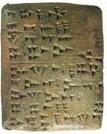 Several Canaanite or early Israelite sites, including 11th c. Ai, mid-11th c. Hazor, and 10th c. Lachish, have a room of unusual plan with a distinctive assemblage of vessels and objects. Each room has benches or a low platform against one or more walls, which is not a feature of either houses or public buildings. The distinctive assemblage consisted of small altars with and without horns (likely for burning incense though none preserved evidence of burnt incense), fenestrated and plain stands of undetermined specialized use, and ceramic vessels primarily for drinking (krater, bowls, dipper juglets, chalices) but also for eating. At 10th c. Megiddo the objects were stacked in storage rather than in a cult room.
Several Canaanite or early Israelite sites, including 11th c. Ai, mid-11th c. Hazor, and 10th c. Lachish, have a room of unusual plan with a distinctive assemblage of vessels and objects. Each room has benches or a low platform against one or more walls, which is not a feature of either houses or public buildings. The distinctive assemblage consisted of small altars with and without horns (likely for burning incense though none preserved evidence of burnt incense), fenestrated and plain stands of undetermined specialized use, and ceramic vessels primarily for drinking (krater, bowls, dipper juglets, chalices) but also for eating. At 10th c. Megiddo the objects were stacked in storage rather than in a cult room.
Perhaps the “men of the marzeah” met in these rooms. From as early as the second half of the third millennium BCE the marzeah is mentioned in texts from the site of Ebla. Textual attestations to the marzeah from thirteenth century BCE Emar and late twelfth century Ugarit, all sites in modern day Syria, demonstrate the continuity of the practice down into the period of early Israel. A general description is possible based on these earlier descriptions in conjunction with biblical (Amos 6- 1, 3-7; Jeremiah 16- 5-9; Hoshea 4- 16-19) and later references (Elephantine, Palmyra, Piraeus, and the sixth century CE Madeba Map). Upper-class men formed a group that owned buildings and vineyards. The group claimed an association with a deity who likely functioned as a divine patron but no rituals or worship is mentioned. The primary function for meeting appears to be to consume alcohol, usually wine, and conduct business. These rooms likely served as drinking clubs for upper-class men to transact joint business ventures. In some cases the marzeah appears to have functioned as a place of mourning for deceased marzeah members and family in general (eg. Jeremiah 16- 5). As a place where members congregate to imbibe, that is should also fulfill a funerary function is not surprising.
Ref- For an archaeological presentation of one such room see Y. Aharoni, Investigations at Lachish- The Sanctuary and the Residency (Lachish V). Gateway, 1975. pp. 26-32, with relevant figures and plates. John Laughlin discusses marzeah in his book, The Marzeah in the Prophetic Literature, 2001.
Elizabeth Bloch-Smith
See also-
- BiblePlaces.com- Lachish
- Bible History Online- Lachish Letters
- The Lakhish Ewer, c. 1220 BCE
- Lakhish Reliefs at Nineveh, c. 700 BCE
- Scholars’ Corner- Yadin Presents New Interpretation of the Famous Lachish Letters, Oded Borowski, BAR 10-02, Mar-Apr 1984.
- Lachish—Key to the Israelite Conquest of Canaan? David Ussishkin, BAR 13-01, Jan-Feb 1987.
- Restoring the Great Gate at Lachish, David Ussishkin, BAR 14-02, Mar-Apr 1988.
- Why Lachish Matters- A Major Site Gets the Publication It Deserves, Philip J. King, BAR 31-04, Jul-Aug 2005.
- The Marzeah Amos Denounces, Philip J. King, BAR 14-04, Jul-Aug 1988.
- Return to Lachish, Steven Feldman, BAR 28-03, May-Jun 2002.